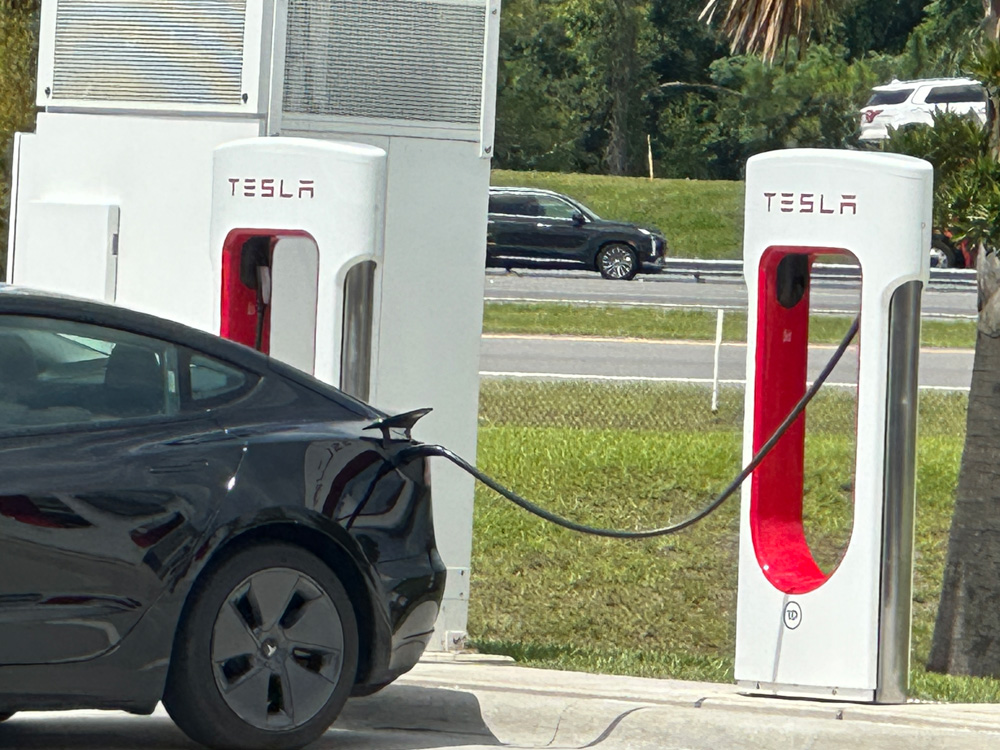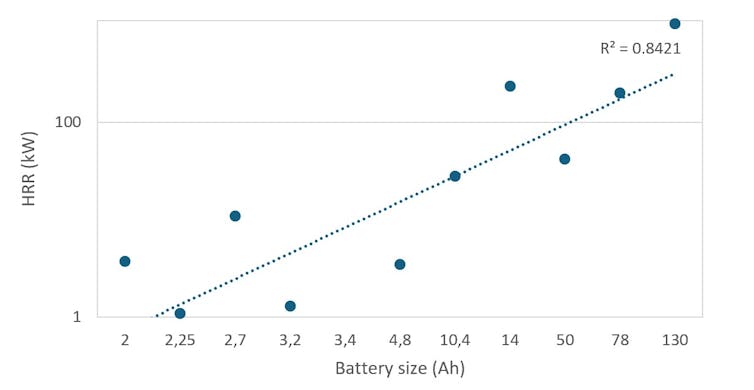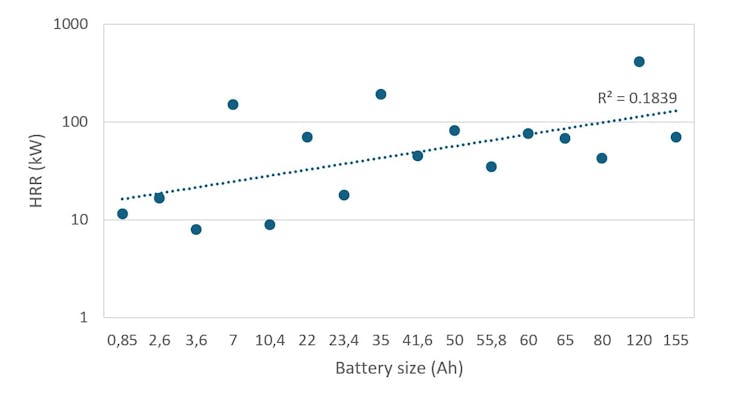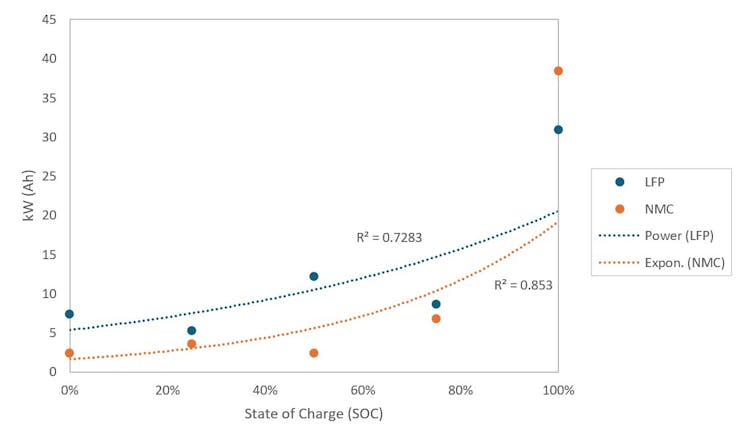
By César Martín-Gómez, Mohd Zahirasri Bin Mohd Tohir and Victor Debeure
Electric vehicles (EVs) bring not just environmental promise, but also raise critical safety questions – chief among them, the fire risks posed by their lithium-ion batteries. While indispensable for powering EVs, these batteries present unique challenges, especially in confined spaces like parking garages, where the potential for fires carries significant consequences.
At the core of this risk lies the lithium-ion battery (LiB), a powerful energy storage device with considerable vulnerabilities. Several of these batteries’ components pose a fire risk, but the part known as the cathode is critical in this regard. These are typically made of either nickel manganese cobalt oxide (NMC) or lithium iron phosphate (LFP). NMC is more cost-effective, but also more prone to thermal runaway, a hazardous reaction that triggers sudden fires in LiB batteries.
Thermal runaway is a self-accelerating reaction that leads to a rapid temperature increase. It is often caused by overcharging, overheating, damage, or defects, and once initiated, it can cause uncontrollable fires that are difficult to extinguish.
The risk of thermal runaway is mitigated by built-in Battery Management Systems (BMS), which include real-time monitoring, automatic deactivation features, and compartmentalised modules to isolate fires. However, as the range and performance of EVs improves, their batteries are getting bigger, making fire safety a serious challenge, especially in indoor environments.
EV battery Types
To better understand the global EV market, we analysed 100 EVs from Europe, Asia, and America, covering various brands and models. The data provided insights into vehicle dimensions, battery types, sizes, and placements.
The findings showed that around 90% of these vehicles use NMC batteries. While preferred by manufacturers for lower production costs, these batteries are more prone to thermal runaway, making them a major safety concern.
A battery’s weight to efficiency ratio is an important consideration for EV manufacturers, often dictating which battery type is used. However, our comparison of NMC and LFP batteries revealed unexpected results. NMC batteries, at 6.74 kg per kWh, are only slightly heavier than LFP batteries at 6.51 kg per kWh.
This minor difference calls the assumed weight-to-energy advantage of NMC batteries into question, especially given their increased fire risk.
Fire behaviour of NMC and LFP batteries
Our research also looked at the fire-related behaviour of NMC and LFP batteries, the two most common EV battery types.
We looked at data from 24 studies, examining experiments that ignited lithium-ion cells to measure Heat Release Rate (HRR) over time – essentially a measurement of how quickly they burn. While insightful, these tests reflect single-cell behaviour. Fires in full EV battery packs, containing thousands of cells, are far more complex, involving chain reactions and additional energy release from the vehicle itself.
Our analysis did, however, reveal notable differences in fire behaviour between NMC and LFP batteries as capacity increases. At lower capacities, NMC batteries show relatively low maximum HRR, but this spikes dramatically at higher capacities, exceeding 100 kW, as the graph below demonstrates.

César Martín-Gomez, Mohd Zahirasri Bin Mohd Tohir, Victor Debeure
In contrast, LFP batteries exhibit more stable HRR, increasing gradually without reaching NMC’s extreme levels. This suggests that NMC batteries pose greater fire risks at higher capacities, emphasising the need to consider battery type and capacity when assessing EV safety, especially for larger packs.

César Martín-Gomez, Mohd Zahirasri Bin Mohd Tohir, Victor Debeure
Battery charge and fire risk
Beyond just battery type and capacity, the study also explored whether the level of charge in a battery – known as state of charge (SoC) – influences the power released during a fire. The data was divided into five segments – charge levels of 0%, 25%, 50%, 75%, and 100% – and a new metric, kW per Ah, was introduced to account for the Heat Release Rate (HRR) as a function of battery capacity.

César Martín-Gomez, Mohd Zahirasri Bin Mohd Tohir, Victor Debeure
The results were clear: from 0% to 75% charge, fire intensity remained stable, but at full charge, fire strength surged to 31 kW/Ah for LFP batteries and 38 kW/Ah for NMC batteries. This increase aligns with real-world incidents, as many fires occur during vehicle charging.
This highlights the importance of effective fire prevention systems at parking lot charging stations, particularly underground, to mitigate risks associated with charging EVs, especially those with high-capacity NMC batteries.
So is it safe to own an EV?
The answer is yes, but only if certain safety measures are followed. Systemic measures, like advanced fire suppression systems in public spaces, are critical, but individual EV owners also play a vital role in minimising risks. Owning an EV with a home-charging setup offers great convenience, but it’s essential to address potential hazards.
Following manufacturer guidelines, conducting regular battery health checks, and equipping your garage with fire protection tools like electrical-rated extinguishers and fire blankets can significantly enhance safety. By taking these proactive steps, we can embrace the future of cleaner transportation with confidence and peace of mind.
![]()
César Martín-Gómez is Professor in energy installations and systems in architecture and urban planning at the University of Navarra,
Mohd Zahirasri Bin Mohd Tohir is a Postdoctoral researcher in fire safety engineering at the University of Navarra, and Victor Debeure is an Industrial Engineer, IMT Nord Europe, Institut Mines-Télécom.






























JimboXYZ says
Relatively comparable, the lead-acid battery of an ICEV can explode just the same, won’t cause a fire like an EV battery pack does as catastrophic. ICEV’s also catch fire for oil & fuel leaks as well. Take your pick for unsafe. I doubt anyone checks their ICEV 12V battery for bulging which is an indication the battery will fail, maybe explode as the fluid level in the battery is too low. A lot of motorists don’t even check their tire air pressures, a blowout from that like what happened with Firestone/Bridgestone tires for all those SUVs in the early 2000’s were motorists that didn’t maintain their tire pressures. That’s if they weren’t motorists trying to squeeze out the last miles of the bald tires with steel belts coming thru the carcasses of the tires. Doesn’t take much for a tire to come apart when the steel belts are contacting the asphalt or concrete for the heat buildup from that friction. There’s always tire rubber rot too if a vehicle is rarely driven or stored for extended periods. A lot of RV’s that sit in storage, boat trailer tires will rot exposed to the elements without being used. Batteries & tires are things that are on the clock for being used or not, getting the mileage out of them. Moral of the story, monitor, maintain & use the vehicle. And there are points where bald tires become unsafe for hydroplaning in rain or just even wet road surfaces. Rarely has Flagler county had nights where the temps dropped below freezing, bu frost is just as bad as freezing ice temps below 32* F. Be aware of that. a few years back the temps did drop into the upper 20’s. I drove my 2013 car for the first time ever in FL and the dashboard warned me that roads may be icey because the temperature sensor & programming at least provided that warning. With the TPMS (Tire Pressure Monitoring System) that warns when air pressure drops below a certain threshold as well. Read the owner’s manual for features your automobile might have.
DaleL says
No where in this story did I read a fire risk comparison with conventional gasoline powered vehicles. Without a true perspective of relative risk, the story is meaningless. A Tesla Model Y, the best selling EV in the USA, has a battery which when fully charged has the energy equivalent of about 2.2 gallons of gasoline. One gasoline powered pickup truck, with a full 20 gallon tank, is the equivalent of 9 Tesla Y’s in energy. Gasoline is also extremely flammable. Data shows that gasoline powered vehicles are nearly 100 times more likely to catch fire than EVs. It is the rarity of EV fires which makes them newsworthy.
https://electrek.co/2022/01/12/government-data-shows-gasoline-vehicles-are-significantly-more-prone-to-fires-than-evs/
Many parking garages have EV chargers. Atlanta has the Atlantic Station parking garage, which I stopped at to charge last year on a trip back from Iowa, with 30 Tesla superchargers. Gasoline is so dangerous that no one in their right mind would ever put a gasoline station in the middle of a parking lot building.
The authors mention the danger of an EV catching fire while charging in a home garage. Once again where is the perspective? Electrical fires are not limited to EVs. Bad wiring has resulted in many home fires. Fires in garages are particularly bad if they involve a gasoline powered vehicle, stored gasoline, stored propane, or painting supplies. A good fire extinguisher should be standard in all garages.
The authors, César Martín-Gómez, Mohd Zahirasri Bin Mohd Tohir and Victor Debeure, have written an EV scare story masquerading as serious science.
So to answer the title’s question, “Electrical Vehicle Fires: Should We Be Worried?”, the answer is: Not Really. The truth is that EV fires are rare. They can be difficult to extinguish because they do not require oxygen (air), but they are also less intense and propagate more slowly than a gasoline fire.
Mark says
In the United States, EVs caught fire at a rate of 25 per 100,000 sold compared with 1,529 per 100,000 gas cars sold.
Article fails to mention that.
TR says
Is your comparison based on cars in an accident or just sitting in ones driveway. Your comment didn’t specify that.
DaleL says
It does not matter; EVs are far less likely to catch fire for any reason. The greatest risk for an EV to catch fire (very low) is while being charged. The greatest risk for a regular vehicle to catch fire is while in operation, including in a crash.
A story on Top Gear BBC states: “Electric car fires are very rare. They might stem from a fault or crash, but no official crash test ever caused one.”
“Last summer a car park at Luton airport (London, England) went up in an inferno. Social media speculation, authoritative as ever, pinned it to an EV fire. Thanks social media for your contribution. The fire brigade later said it was a diesel car.”
https://www.topgear.com/car-news/mythbusting-evs/mythbusting-world-evs-are-electric-cars-susceptible-catching-fire
Top Speed has a story on crash safety: “The absence of a gasoline tank, which reduces the possibility of a fuel leak or fire in the case of an accident, is another advantage of EVs in terms of safety. This is a big benefit versus ICE cars, which in the case of a collision, may pose a serious danger to passengers and emergency personnel. EV passengers have a lower probability of suffering fire-related injuries or death than passengers of ICE vehicles, according to research by the National Highway Traffic Safety Administration.”
https://www.topspeed.com/heres-why-evs-safer-in-crash/
Denali says
In order to be relevant, realistic and trusted, testing such as this must be conducted by a certified and independent third party test lab such as Underwriters Labs. Independence is the key. We have no idea what preconceived notions these folks had prior to beginning their research. Were they or are they motivated by some outside source such as a manufacturer or material supplier? Do their test methods and procedures meet peer review? What ASTM, NIST or CPSC standards were followed?
From an article that the authors reference; “Once the onboard battery (is) involved in fire, there is a greater difficulty in suppressing EV fires, because the burning battery pack inside is inaccessible to externally applied suppressant and can re-ignite without sufficient cooling. As a result, an excessive amount of suppression agent is needed to cool the battery, extinguish the fire, and prevent re-ignition.” They then suggest that a typical homeowner attempt to mitigate the fire with a fire extinguisher or smother it with blankets. This is not the answer. The first thing any firefighter will tell a civilian is to get out of the building.
If this issue is such a concern perhaps the LI batteries need to be redesigned or we need to look at on-board large volume CO2 systems.